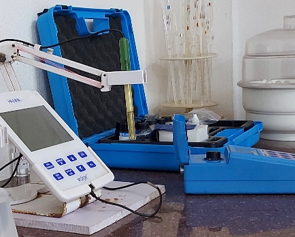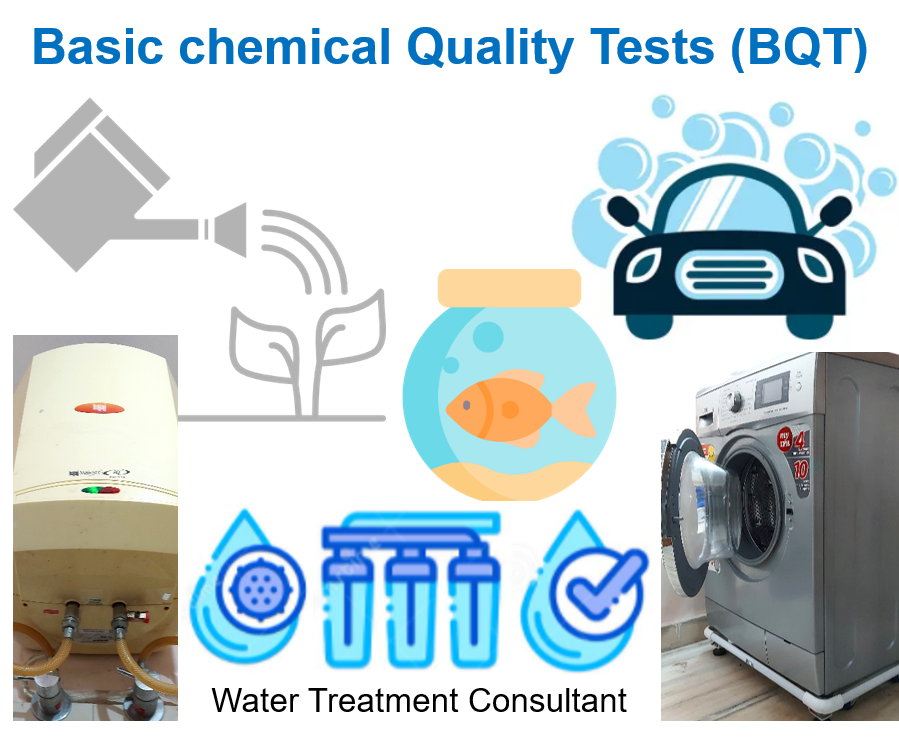Basic chemical Quality Tests (BQT)
Scope:

Physical & Sensory Parameters:
Colour (Appearance & True Colour Units), Odour, pH, Turbidity; Electrical Conductivity (EC); Total Dissolved Solids (TDS) estimated from EC (TDSE).
Note: the physical & sensory parameters are same as in BPT.

Chemical Parameters:
Total hardness of water (THW), Calcium (Ca) & Magnesium (Mg); Ammoniacal-Nitrogen (NH3-N), Nitrites (NO2) & Nitrates (NO3); Fluoride.
Note: the chemcial parameters are same as in BPT.
Total parameters: 6 + 7 = 13 + 1 Estimated value (TDSE)
Rationale:
Many consumers access water from multiple sources, to maximise total availability and minimise costs. Available water sources are often differentiated by designated use. For example; borewell water may be used exclusively for general purposes such as washing, gardening, etc. Farms, institutions and industries often have designated borewells for specific purposes for which physical and chemical profile is relevant. Sometimes consumers have access to a water source, and want to know its physical-chemical characteristics to plan appropriate use and/or to design water treatment systems. For example; mineral content is an important consideration in designing water treatment units. Water softener units may have to be incorporated to deal with excessive hardness of feedwater. Reverse osmosis (RO) units are required to treat saline water. The chemical Quality Tests are designed to address various water quality questions and concerns other than potability.

BQT is BPT minus the bacteriological parameters. In BQT we have packaged a minimal set of physical and chemical parameters, to check for hardness, nitrogenous substances in addition to physical and sensory characteristics. Fluoride is included as fluorosis is endemic in some areas around Hyderabad. TDS value would be a range estimated from electrical conductivity. However, if you need to know level of chloride which would help assess suitability for gardening, or acid buffering capacity (alkalinity) that gives some idea about interaction of the water with plumbing system and appliances, then basic mineral tests (BMT), tap water quality tests (TQT) or groundwater quality tests (GQT) would be better options.
In the past, home owners have ordered BQT to check suitability of borewell / open well water for general use and domestic purposes such as car washing. Water treatment consultants and water purifier suppliers have ordered BQT as the first test to give preliminary idea about appropriateness of various water treatment technologies and choice of purifier models. For example; community development organisations and social workers, wanting to improve quality of water for villagers have brought samples from Gram Panchayats borewell and have ordered BQT to know if putting up of a RO plant would help. Occasionally clients simply want “to know quality of water” and order for BQT.
Occasionally, clients intend to use a water for drinking and order for BQT, despite our advice that bacteriological coliform tests are essential for determination of potability. If physical and chemical characteristics of a sample do not satisfy the guideline values for drinking water, or indicate probable contamination, then it would be possible to say that the water is not potable. However, even if the physical and chemical characteristics test in a chemical Quality Test package are within acceptable/permissible limits for human consumption, we cannot say that the water is potable, without bacteriological testing to rule out faecal contamination.
Sample - Collection, Storage & Transportation:
Follow methods of sampling specified in IS 3025 part 1 : 1987 for chemical tests. One litre sample collected in a clean and dry clear or amber colour polypropylene bottle (CBWS/ABWS) is required for physical and chemical tests. Collect sample from the pump delivery pipe or a tap closest to the well head. For open wells without any pump, use a clean bucket or pot to draw water. In case of step wells, ponds etc. plunge the bottle into the water elbow-deep, then turn it right side up to collect the sample from below the water surface. Transport the sample to laboratory as soon as possible, preferably within six hours. If immediate transport is not feasible, store the sample in a cool box and transport to laboratory, within 24 hours.
Information About Source, Context, Intended Use & Concerns:
Provide as much detail as you can about the source of water, sampling point, activities & environment around the sampling point, details of how the sampling point is linked to the source, recent maintenance event (servicing of water purifier, cleaning of overhead tank, sump, repair and renovation of plumbing, etc.) if any. Mention about intended use of the water, the reason why you are ordering the test, as well as doubts and concerns, if any. Occasionally, the IHS Laboratory may contact you for clarifications and additional information about the source and its environment, to help interpretation of test results.
Test Method & Duration:
Sensory, physical and chemical characteristics of water sample are tested according appropriate parts of the IS3025 and/or American Public Health Association (APHA). Report will be available in 2 to 3 days.



To pick up sample collection bottle and/or schedule collection of samples: Email: ihslab@ihs.org.in with your address and contact telephone; OR WhatsApp: +919848011251; Or Call: 23211013/4.
References:
- APHA. 2017. Standard Methods for the Examination of Water and Wastewater, 23rd Edition. Washington, DC: American Public Health Association (APHA), American Water Works Association (AWWA), and Water Environment Federation. https://www.standardmethods.org/
- IS 3025 Part 1: 1987. Methods of Sampling and Test (Physical and Chemical) for Water and Wastewater. Part 1 Sampling. New Delhi: Bureau of Indian Standard (BIS); Indian Standard. Reaffirmed 2003. https://law.resource.org/pub/in/bis/S02/is.3025.01.1987.pdf
- IS 3025 Relevant Parts: 1983. Methods of Sampling and Test (Physical and Chemical) for Water and Wastewater. Parts, 4, 10, 21,46 etc. New Delhi: Bureau of Indian Standard (BIS); Indian Standard. https://www.services.bis.gov.in/php/BIS_2.0/bisconnect/knowyourstandards/indian_standards/isdetails
